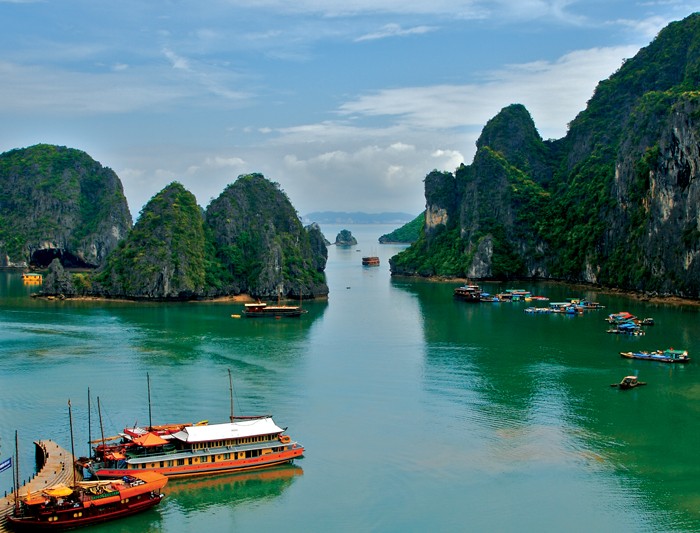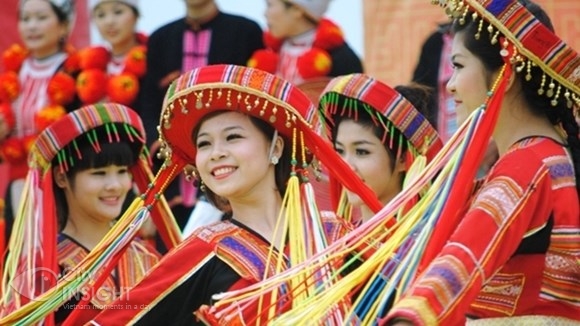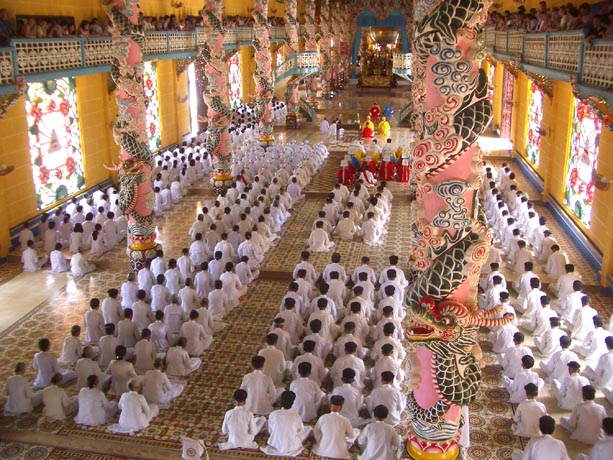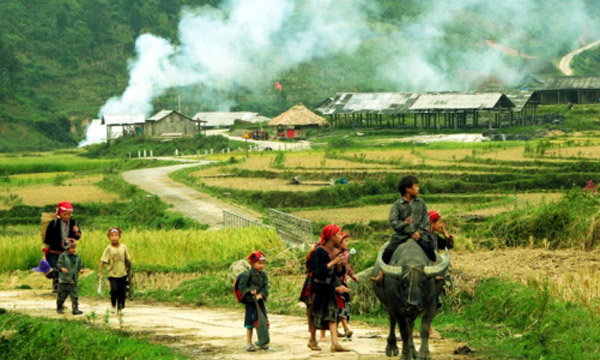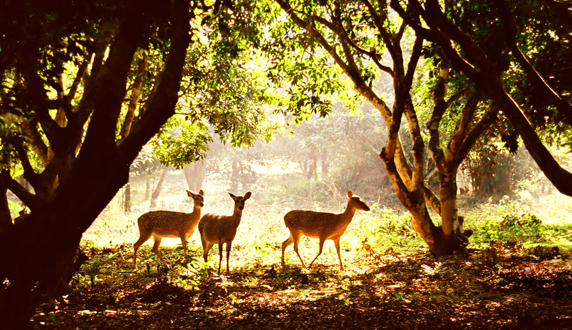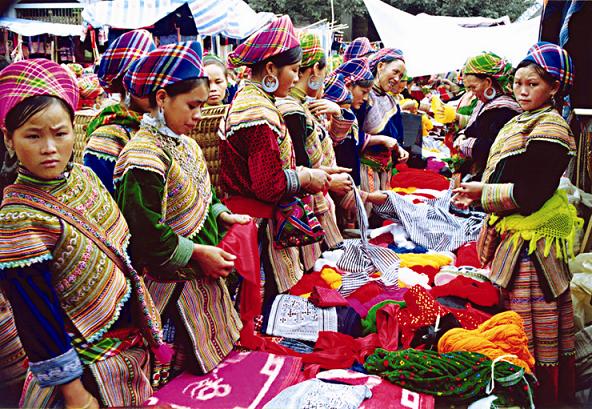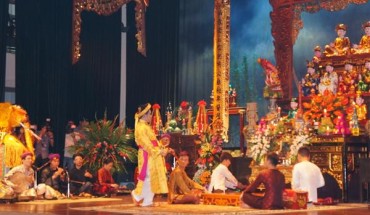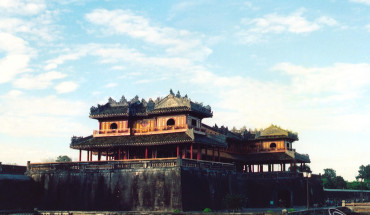Lush green mountains, scenic beaches, ancient pagodas, and the allure of a fascinating culture attract millions of visitors to Vietnam each year. Today, the country is emerging as an increasingly prosperous nation with a thriving tourism industry, largely due to recent economic reforms and a successful effort by its people to emphasize that Vietnam is “a nation, not a war”.
Bounded by the warm waters of the East Sea, Vietnam is in the southeastern corner of the Indochinese peninsula. To the country’s west are Laos and Cambodia, separated from Vietnam by the Annamite Mountains or the Truong Son Range, while to the north lies the great bulk of China. Vietnam itself is long and thin just 50 km (31 miles) wide at its narrowest with an extensive coastline stretching from the Gulf of Tonkin in the north to the Gulf of Thailand in the south.
The Vietnamese generally divide their country into three regions. In the north, dominated by the charming capital Hanoi and hemmed in by mountains on three sides, is the fertile Red River Delta. The long central part of Vietnam is marked by several scenic beaches, the former imperial city of Hue, the mercantile town of Hoi An, and the large port city of Danang, along with remnants of the Demilitarized Zone (DMZ). In its lower half, it broadens and is home to the highlands around Pleiku and Dalat. In the far south lies burgeoning Ho Chi Minh City, Vietnam’s commercial hub, and the Mekong Delta. Characterized by palm trees and numerous canals, this bucolic region is the country’s largest rice-producing belt. Vietnam’s geographical diversity is reflected in its people, and the nation is home to 54 recognized ethnic groups. The largest, Viet or Kinh, constitute 86 percent of the nation’s 84 million people and live mainly on the coastal plains and in the delta regions. Most of the ethnic minorities inhabit the Northern and Central Highlands are distinguished by their colorful garments. The ethnic Chinese or Hoa, by contrast, are mostly based in the lowlands and major cities, while the Cham and Khmer are settle in the southern coastal plains and the Mekong Delta.
Culture
The traditional structure of Vietnamese society has always been hierarchical and patriarchal. Drawing heavily from the Confucian model, family and filial duties are upheld as cardinal virtues. Elders are given respect and education is highly esteemed. The role of women has changed since their emancipation by the Communist regime. Today, although women have gained equality in the public sphere, the home is usually still “run” by a woman.
Vietnam’s culture is made more fascinating by the foreign influences it has assimilated over the centuries. Nearly 1000 years of Chinese occupation has left its mark on the Vietnamese, who have selected and adopted those customs, traditions, beliefs, and architecture most suited to their culture. It is, however, a love-hate relationship, with Vietnam emulating Chinese culture while rejecting any form of political domination by its northern neighbor. The impact of the French, who attacked Saigon after a wave of Catholic executions in the 19th century and went on to conquer the country, is less comprehensive. The colonial power’s influence is most visible in the distinctive architecture of the cities and, to some extent, in the food.
Some overseas Vietnamese or Viet Kieu, who fled the country as refugees from the communist North in the 1950s and from the South in 1975, are now returning and bringing Western cultural influences with them. While members of the older generation refuse to visit their former homeland, still ruled by the very people who forced them into exile, others are coming back to set up businesses or discover their “roots”.
Tourism and the media have also played a role in the Westernization of the culture, which is evident among urban youngster. Learning English is a craze, cell phones are coveted, and jeans and designer clothing are common. Even up to a decade ago, Vietnam was known for its austere fashions, but today, it is an emporium for purchasing clothes, accessories, and home ware in luxurious fabrics and funky designs. Western-style clothing is popular among young women but the traditional ao dai or trouser dress continues to be worn, particularly on special occasions.
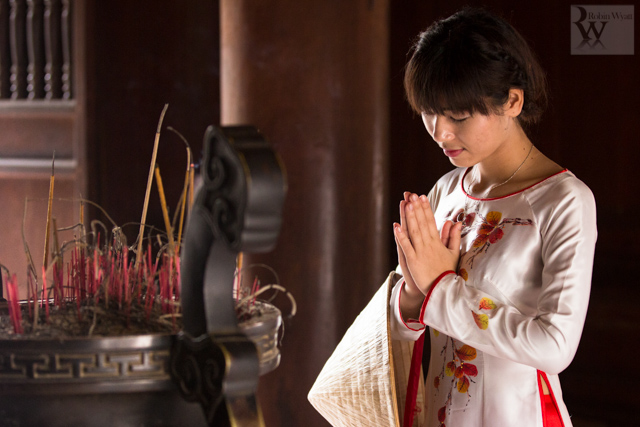
A young Vietnamese student offers prayers for success in her studies at Hanoi’s Temple of Literature.
Religion
During the communist years, atheism was officially promoted, but in the new area of pragmatism, old faiths and traditions are re-emerging. Vietnam has long embraced a mélange of faiths based on Tam Giao or the Triple Religion of Buddhism, Taoism and Confucianism, to which has been added ancestor worship, indigenous spirit beliefs and even Hindu traditions from ancient Champa. The country is also home to a large Catholic population, and idiosyncratic faiths such as Cao Daism and Hoa Hao. These are all tolerated, provided they do not threaten the Communist Party’s hold on power.
Language and Literature
Vietnamese or Tieng Viet is the national language of Vietnam, spoken by around 87 percent of the populations as their first language. Until about AD 1000, there was no written form of Vietnamese, but in the 11th century, a system called chu nom was introduced using adapted Chinese character. In the 17th century, a Romanized script, quoc ngu, was developed by European missionaries, which has become the accepted script. However, there are regional and intra-regional variations in dialect throughout the country.
Vietnam has a rich literary heritage, written in Chinese, chu nom, and quoc ngu. The epic poem, The Tale of Kieu, written by mandarin and scholar Nguyen Du (1766 – 1820), is a classic morality tale widely regarded as the greatest work in Vietnamese literature. Also famous are the poem of high-ranking concubine, Ho Xuan Huong (1775 – 1825), known for her witty verse. Today, as a result of gradual political liberalization, a new style of writing has emerged the explores “forbidden issues”, and focuses on the plight of the individual. Bao Ninh is a popular writer whose novel Sorrow of War is a powerful account of the Vietnam War. Some contemporary names include Pham Thi Hoai, Nguyen Huy Thiep, Duong Thu Huong.
Economic Development
Once among the poorest nations of the world, Vietnam is currently experiencing an unprecedented economic boom. The credit for this primarily goes to the introduction of doi moi (economic reforms) in 1986, which permitted the setting up of free market enterprises, abolished the practice of collectivized farming, and set the stage for political liberalization. After China, the country boasts Asia’s best-performing economy, with an annual growth rate of more than eight percent. In 1993, the World Bank declared 58 percent of the population to be living in poverty. By 2005, this figure was less than 20 percent. Agriculture remains the most important element of the economy, forming a major portion of the country’s export sector and employing nearly 65 percent of the population. Today, Vietnam is the world’s third-largest exporter of rice an astounding feat for a nation facing famine in the 1980s.
The industrial sector has shown immense improvement and expansion as well. Mining continues to be an integral part of the economy, and oil, gas, and coal production account for more than 25 percent of industrial GDP. The tourism industry is one of the largest earners of foreign currency in the country. Vietnam has also made great strides on the international stage. In 1995, it became a full member of ASEAN, and of the WTO in 2006.
The effects of this new-found prosperity can be seen everywhere. Large, glitzy malls have cropped up in major cities, while streets once filled with bicycles are now overflowing with locally produced Japanese and Korean motorbikes and air-conditional cars.
Conservation
Despite its increasing wealth, Vietnam remains a poor country with a rapidly expanding population and limited land resources. By 2020, Vietnam is projected to have around twice of Thailand’s population, but with less than half the arable land. According to the World Conservation Monitoring Center, at present around 30,000 ha (74,000 acres) of forest is lost annually. Both plant life and wildlife have suffered at the hands of hunters and farmers, but the Vietnam War’s effects have perhaps had the greatest long-term impact on the environment. Incendiary bombs and the defoliant Agent Orange decimated the country’s foliage, destroying arable land and erasing habitats.
Fortunately, the outlook for Vietnam’s nature is improving now. New laws protecting forests and endangered species are being introduced every year, in keeping with Ho Chi Minh’s 1962 pronouncement that “forest is gold”. Tourism has indirectly had a positive impact on the environment by providing a new source of income that can prove far more profitable than hunting and logging.
Tourism
When Vietnam first opened to tourism in the early 1990s, many visitors were drawn by images of a war-torn nation. The Viets have since done their best to change this view, emphasizing the country’s beauty instead. Historic pagodas and faded French colonial buildings have been restored, while hotels and restaurants have now returned to the private sector, allowing proprietors to strive for excellence in an increasingly competitive industry. The country’s road and rail transport infrastructure needs major upgrading, but its airports and national airline now offer a high standard of service.
The tourism industry is growing at almost 20 percent annually and millions of visitors are drawn to the country each year by ancient monuments, scenic beaches, sophisticated cuisine, excellent shopping opportunities, and the warmth of the Vietnamese people. Another positive outcome of the country’s tourist boom has been the resurgence of traditional culture, including music, dance, and drama. Old festivals are being re-established, and arts such as water puppetry are flourishing.
Landscape and Wildlife
Vietnam is one of Asia’s most ecologically diverse countries. Habitats range from the cool mountains of the northwest, through the narrow coastal plains and highland plateaus of the center, to the delta regions of the Red and Mekong Rivers. Especially noteworthy for wildlife enthusiasts are the expansive national parks of Northern Vietnam, filled with fascinating flora and fauna. For sightings of indigenous and migratory birds, the Mekong Delta offers some of the best opportunities, while offshore are numerous islands, some with pristine coral reefs.
– The Deltas
The broad and fertile Red River Delta forms the heartland of Northern Vietnam, while Southern Vietnam is dominated by the rich alluvial lands of the Mekong Delta. Most of Vietnam’s rice is produced in these belts. However, while the Red River Delta is almost completely given over to agriculture, the Mekong Delta is also home to wildlife-rich marshlands and mangrove forests.
– Central Highlands
Embracing the southern reaches of the Truong Son Range, the topography of the Central Highlands varies between craggy mountains to the far west, and fertile plateaus towards the interior. The red volcanic soil around Pleiku and Kontum supports coffee, tea, and rubber plantations, while the mountains are home to jungles with many species of flora and fauna.
– Central Coastline
The upper center comprises a very long and comparatively narrow strip of coastal flatland running along the choppy waters of the East Sea. While the land is not as productive as the delta regions, it is home to some beautiful beaches, especially around Nha Trang in the lower half of the central coastline.
– The Northern Mountains
The northern mountains all but encircle the Red River Delta on three sides. Sharp, jagged peaks rise above long mountain valleys, forming the most inaccessible part if the entire country. The forest-clad slopes of the northwest once provided a safe retreat for flora and fauna, but today new roads, logging, and human settlement pose an increasing threat to the area’s natural beauty.
Peoples of Vietnam
Vietnam is home to a diverse mix of more than 54 ethnic groups. Of these, the Kinh or ethnic Viet of Mongolian origin, make up around 86 percent of the population. Settled along the coast and in the Red River and Mekong Deltas, they share the plains with the Hoa or ethnic Chinese, as well as the Khmer and Cham. A further 50 ethnic groups live scattered across the Northern and Central Highlands, all with their own distinctive custom, clothing, and languages. While the northern groups, such as Thai and H’mong, have mostly migrated from China, those of the Central Highlands are mainly indigenous.
The Khmer are of Cambodian origin and still follow many of their customs such as Prathom Sva Pol or the Monkey Dance, which is performed during the Oc Om Boc Festival. Dancers don exotic masks and simulate simian behavior during the show.
The Bahnar people of the Central Highlands center their cultural activities around nha rong or communal houses. With distinctive upward tapering roofs, these buildings are inaugurated with gong music, dancing and jar of rice wine.
Cham Muslims or Cham Bani follow an indigenous form of Shiite Islam. Friday prayers are chanted by a group of about 50 priests, who dress in white sarongs and cover their shaved heads with a ceremonial turban.
The Bru live in the Central Highlands and belong to the Mon-Khmer group. They rely on wet rice farming and enjoy lively folk music for entertainment. A common habit among the Bru is smoking tobacco and adults, as well as children, can be seen with a pipe in their mouth.
The second largest ethnic minority in Vietnam, the Thai are divided into Black, White, Red subgroups based on the color of their clothing, as well as on the basis of their early settlements around the Black and Red Rivers respectively. The Black Thai are the most industrious and prosperous of all the subgroups, farming rich rice paddies in the uplands of the northwest. Although a high value is set on education, they are faithful to their cultural heritage. They continue to perform spirit worship, and have kept their ancient folk songs and dances alive and unchanged through the centuries.
Flower H’mong women are among the most distinctive of all minority groups. They dress elaborately with layers of colored cloth, and devote much of their time to the exquisite embroidery for which they are famous.
The Muong are justly celebrated for their weaving skills. They usually place their bamboo loom in the shady space under their thatched stilt houses.
The Red Dzao subdivision of Northern Vietnam’s Dzao minority group derives its name from the brilliant red turbans worn by the women, who beautify themselves by shaving off their hair and eyebrows. Arguably the most enterprising of the highland peoples, the Dzao make a living farming, weaving, and paper making. They also have a rich literary heritage, which is written in a variation of the Chinese script.
You may be interested in our products at Vietnam tours or Vietnam hotels here.


